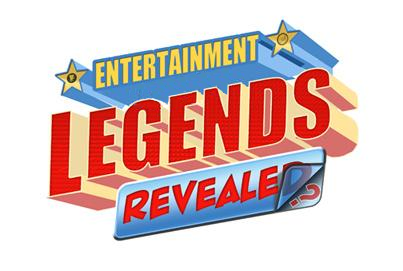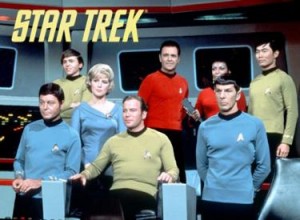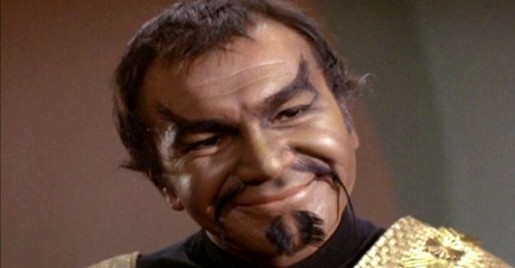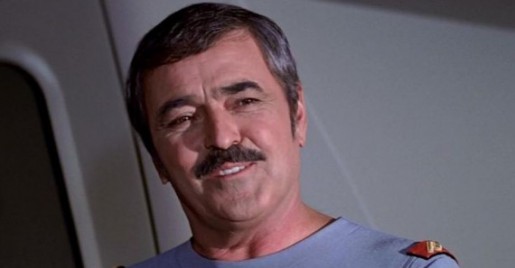Which Member of the Original Star Trek Cast Invented the First Klingon Language?
Here is the latest in a series of examinations into urban legends about TV and whether they are true or false. Click here to view an archive of the TV urban legends featured so far.
TV/MOVIE URBAN LEGEND: One of the original cast members of Star Trek invented the first Klingon language.
There are some common areas where actors can influence the television shows that they appear on, with the most common being the background of the characters that they play. For instance, it is no coincidence that Fox Mulder on The X-Files likes the New York Knicks, just like the actor who plays Mulder, David Duchovny. Many of the most heartwarming early episodes of Glee involving Kurt were based on the life experiences of Kurt actor, Chris Colfer.
However, there are also less common areas where actors can influence their shows, like the case of the crewmember of the U.S.S. Enterprise who came up with the original Klingon language!
Read on to see which surprising regular cast member of the original Star Trek series first coined the Klingon language!
It is important to understand just how much of an influence budgets have on the plots of television shows, even to this day. Look at a show like DC’s Legends of Tomorrow, which much do complicated (and expensive) special effects every time they use the character Firestorm on the show. Therefore, the writers naturally have to avoid using Firestorm too much. That, though, has a great influence on the plot of the series as Firestorm is powerful enough that the natural impulse at times would be to have Firestorm clean up messes. This is avoided by coming up with reasons to split up the two characters, Martin Stein and Jefferson Jackson, that merge to form Firestorm. If they’re not together, they can’t form Firestorm. So it is up to the writers to come up with compelling reasons why the two don’t just always remain next to each other. “Professor Stein’s scientific expertise is needed here but Jefforson’s skills as a mechanic are needed there” – stuff like that.
That was certainly the case on the original Star Trek television series, only since it was the late 1960s, the budget issues were slightly more mundane, like costly and time-consuming makeup for the actors. We’ve discussed in the past how the depiction of Spock on Star Trek changed dramatically based on the makeup used on the character, as there obviously were no Vulcans to compare Spock to (heck, at one point, Spock wasn’t even going to be from Vulcan, he was going to be from Mars!), so he underwent a series of makeup changes until they came to the look that Leonard Nimoy made famous (even there, Spock’s pigmentation was confusing to the network color technicians, who would adjust the color on Spock to make him look like everyone else).
Similarly, when the Klingons made their debut in the late Season 1 episode, “Errand of Mercy,” they had even cast an actor to play the Klingon Kor without actually knowing what he was going to look like! When John Colicos showed up for his first day of make-up, he figured they’d be ready for him, but he discovered that they were curious as to what he thought the character would look like! Colicos later recalled, “I said, ‘You don’t know either?'” So Colicos and the makeup artist, the great Fred Phillips, brainstormed for a while. They knew that the Klingons were sort of meant to be futuristic versions of Russians (with the Federation and the Klingon Empire being in the middle of a sort of Cold War), but Colicos instead suggested a look inspired at first by Genghis Khan. He then said, “Spray my hair black, give me a kind of swamp creature green olivey mud reptilian make-up, and we’ll borrow some stuff from Fu Manchu, and put a long moustache and eyebrows on me.” Phillips came up with that brown-green make-up and the original Klingon look was born.
The Klingons were not meant to be major villains on the series, but the issue is that the alien race that was intended to be the major villain, the Romulans, were too impractical to use as regular villains, since their Vulcan-like pointy ears would require a number of actor-specific latex ears being produced, which would be too costly and too time-consuming. So the much simpler “throw some green-brown makeup and mustaches on them” approach of the Klingons became a time and cost-saving technique. As time went by, though, the Klingons also were just more interesting characters for the show’s writers period.
Along the way, the writers discussed giving the Klingons their own language, even making reference to such a language in the classic episode, “The Trouble With Tribbles,” but the language did not show up until Star Trek: The Motion Picture, in which actor Mark Lenard plays an unlucky Klingon captain (Lenard famously played both the first Romulan on the series in Season 1 but then later played Spock’s father, Sarek, in a number of appearances in Star Trek films and series). You’ll notice that this was also the time that the franchise developed the now famous ridged brow look for the Klingons, as the increased budget that came with the film allowed much better makeup.
Amazingly enough, the original language was devised by James Doohan, who played Chief Engineer Montgomery “Scotty” Scott!
As Lenard later recalled, Doohan recorded Lenard’s lines on a tape, which he then gave to Lenard. Lenard transcribed the tape phonetically and then used that to deliver his lines later. We don’t know how much Lenard improvised, nor do we know if Doohan had anything in mind for the language beyond the dozen or so essentially nonsense words that he had Lenard say in the film.
Leonard Nimoy, who came aboard to direct the third Star Trek film, Star Trek III: The Search for Spock, had linguist Marc Okrand, who had created some Vulcan lines for Star Trek II: The Wrath of Khan, take Doohan’s words and create a full working language (with grammar and everything) from it. Okrand’s work is the famous Klingon language that we all know today.
But it all began with Scotty!
The legend is…
STATUS: True
Thanks to Michael Adams’ From Elvish to Klingon: Exploring Invented Languages for the language information and thanks to Memory Alpha, Star Trek: Deep Space Nine – The Official Poster Magazine and Star Trek: Aliens & Artifacts for the Klingon/Romulan information.
Be sure to check out my archive of TV Legends Revealed for more urban legends about the world of television. And click here for more legends just about Star Trek!
Feel free (heck, I implore you!) to write in with your suggestions for future installments! My e-mail address is bcronin@legendsrevealed.com.








